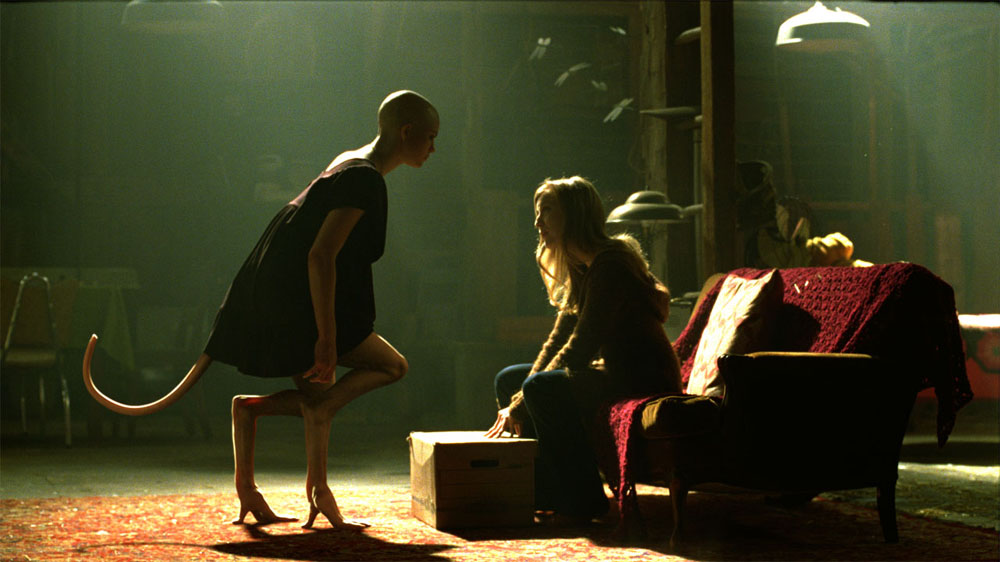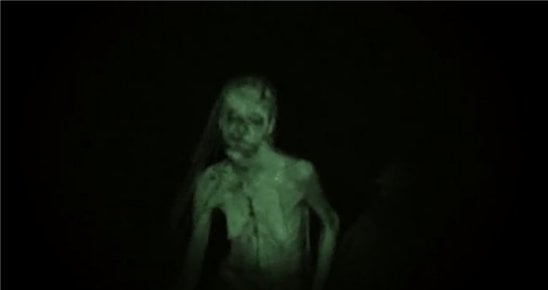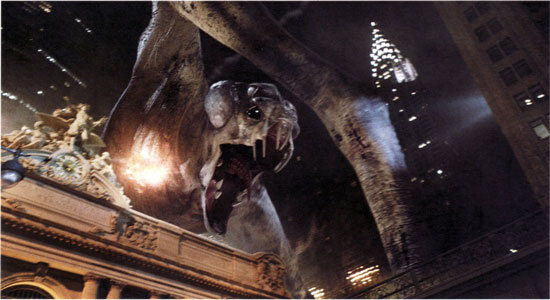The 1980s saw a huge surge for monster design with some of the most iconic monsters in film history coming out of that one decade, unfortunately the advent of CGI have not been too kind to movie monsters, and many of the CGI creations of the past twenty years have been totally flat. The genre itself seems to take a dip entirely in the 90s, often relegated to pre-existing franchises which have already worked their way into the collective consciousness. This list was made in the hopes of highlighting a handful of monsters that made their debut in the 21st century that will hopefully inspire a new generation of special effects artists and filmmakers to continue to test audiences with innovative designs and interesting postulations regarding monstrosity in our society. I am specifically excluding human monsters (by that I mean serial killers or most offensive human beings) as well as designs based off of designs from previously established franchises. This list is not ranked, and is not complete. Be sure to let us know what your favourite monsters are, and why!
Stitch in Lilo & Stitch (Dean Deblois & Chris Sanders, 2002)
Breed: Alien/Genetic Experiment
Style: Animated
Not all monsters have to be dastardly and revolting, and Stitch exemplifies the misunderstood adorable monster. Stitch is part alien, part genetic experiment and was created to be a weapon. His cute appearance, which often likens him to a lap dog or rabbit, disguises from humans his intense desires to destroy just about everything in his path. As this is a Disney film, Stitch is never truly menacing and the film plays heavily on the irony of his cute appearance in contrast with his more sinister origins. Of course, over the course of the film Stitch learns about family and love and more or less reforms. The placement on the list is in homage to a child’s first introduction to the possibility for monstrosity in the world, and the idea that appearances may be deceiving. Stitch may not be monstrous in an evil sense, but he nonetheless embodies the monstrosity of the other, being something or someone who does not belong.

Monster in The Host (Joon-ho Bong, 2006)
Breed: Sea Monster
Style: Animatronics and CGI
One of the most innovative monsters to hit the screen, the monster from The Host seems to be part fish, part amphibian. It has a very peculiar physical appearance and is strangely one of the most credible monsters in film history. The creature’s design is owing to visual effects artist Chin Wei-chen, with work done by both Weta and The Orphanage to bring the monster to life. Considering the budget limitations and the sheer amount of screentime this creature has – even in broad daylight, the design and execution is nothing short of perfect. This is one of the very best designs in recent memory and offers a true compelling threat within the film. As The Host works as a satire, in particular addressing an environmental crisis that hit the country at the dawn of the 21st century and is rather critical of both the USA and South Korean government, this creature follows the path of Godzilla representing an allegorical threat for political dissatisfaction and oppression. The Host similarly blends horror, drama and comedy to great effect, making this a rather unique entry in the monster genre.

Pale Man in Pan’s Labyrinth (Guillermo Del Toro, 2006)
Breed: Fairy Tale Monster
Style: Practical effects
Without question my favourite monster on the list, Pale Man is one of the most horrifying creatures to be created for the screen. Del Toro has consistently demonstrated his ability to circumvent using computer generated imagery in favour of more traditional practical effects to incredible results. Pale Man represents the pinnacle of this design and we feel the real weight and presence of this creature, long before he is put into action. His fleshy skin tone and droopy skin gives him the air of an unusual human, whereas his eyes that he wears in the palms of his hands suggest something far more fantastic and sinister. The great achievement of this design is the humanity that exists within it, as it seems uncomfortably familiar to bodies that we seen in our everyday lives. They are not necessarily bodies that are repulsive and horrific – on the contrary, there is almost a fragility to the form that the pale man has, exasperated by his stilted walk and limited eye-sight. It is though it’s appetite for beauty and innocence that sets it apart, a true creature of nightmares. Also have to give credit to Doug Jones, the man behind the mask, who also plays the Fawn in the film.
Tristana Medeiros in [rec] (Jaume Balagueró & Paco Plaza, 2007)
Breed: Zombie
Style: Practical effects
Possibly my most contentious choice, as zombies are not usually the most compelling of monsters. Zombies are horrific for their bastardization of death and their resemblance of corpses is innately upsetting, however, they rarely stand out as particularly compelling designs. In regard to [rec] the zombie I am specifically referencing is that of Tristana Medeiros who appears in the film’s final sequence in the attic and if you haven’t seen the film, I recommend you stop reading now. What sets this zombie apart from all the others is actually thanks to the actor, Javier Botet, whose unique physicality gives him an edge that no animatronics, CGI or make-up could ever achieve on its own. Javier suffers from Marfan syndrome, a genetic disorder characterized by extreme height, and particularly long limbs. This matched with the dark interior setting and very effective prosthetics creates a truly unique vision of horror. Botet’s first appearance is truly shocking and unlike most CGI effects, feels totally rooted in our reality. It is the blind movements of the creature in particular that makes it so horrific, as it’s menace seems exasperated by the blind rage it displays as it searches for its victim in the dark apartment. We even seem to feel its presence when it’s not on the screen and we fear so completely that it may return at any moment. The presence of this particular zombie is one of the many reasons why [rec] stands out among the over-saturation of zombies in contemporary culture.
Monster in Cloverfield (Matt Reeves, 2008)
Breed: Old School Giant Monster and spawn
Style: CGI
The Cloverfield viral marketing campaign is one of the most compelling attempts at utilizing the internet to create buzz for an original screenplay since The Blair Witch Project did it in 1999. Using a variety of approaches, and leaving so much under wraps until the film’s release, the film effectively created a buzz befitting the larger than life monster that terrorizes New York City in this film. Cloverfield is an extremely divisive film, whose cast of characters and shakey cam aesthetics turned out to be deal-breakers for many audience members. Love it or hate it, it’s hard not to give the film and it’s makers credit for bringing the monster back into American cinema in a big way. It had been a long time since an American film had successfully integrated such a large scale creature with any success, and this film in particular evoked the anxieties and fears that pervaded in post 9/11 America. As for the creature design? It’s fucking awesome; unlike just about anything you’ve seen before it’s a strange hybrid of a Cthulhu-esque sea creature with some freaky ass spawn. Cloverfield will no doubt prove to be one of the most important horror films of the decade in retrospect, in particular for putting both Drew Goddard and Matt Reeves on the map, both responsible for some of the best films of the year in 2010 and 2012.

Dren in Splice (Vincenzo Natali, 2009)
Breed: Genetic creation
Style: Practical and CGI
Canada has long established itself as one of the strongest horror producing countries in the world, and in particular the contribution of David Cronenberg consistently raised the level of special effects – in particular in relation to the body – to new heights. Splice comes out of this legacy, addressing particularly contemporary concerns of genetic experimentation, though it does owe a lot to Mary Shelley’s Frankenstein… as many films of these types do. Dren is a particularly interesting monster, as she is effectively raised as human and exists as a dependent for the majority of the running length. Up until the film’s final act, Dren can only be called a monster by virtue of her design which isolates and marginalizes her as she becomes more self-aware of her role as a monster. Her transition throughout the film as she grows older is nothing short of amazing, the evolution of her design is credible and always surprising. One of the few entries on the list in which the monster is aware of their otherness, it adds an interesting dynamic to the film. Splice is not necessarily the best film out there, but it is really like nothing else you’ve ever seen.
Boonsong in Uncle Boonmee who can Recall his Past Lives (Apichatpong Weerasethakul, 2011)
Breed: Red Eyed Monkey Spirit
Style: Practical and CGI
Genre filmmakers do not have a monopoly on monsters and especially in recent years, it seems that more arthouse filmmakers have ventured into the realm of fantasy and monsters. Apichatpong Weerasethakul is one of the most compelling examples, as many of his films blur the line between natural and urban environments, heavily invested in the spiritualism of these places. Foregoing any sense of beginning and end when it comes to life, the film stipulates a cyclical perception of consciousness. It suggests that we can exist in multiple plains of time and space and under different forms. The monster of the film is Boonsong, the missing son of the title Uncle Boonme. It seems as though he met an untimely end in the forest, and as a result returns as a red-eyed monkey spirit. He resembles, more or less, a man in an ape suit but with glowing red eyes. This should be a little silly, but the film’s tone and conversations lend credence to the concept through the normalization of death and the eternal nature of the soul. The film earns a spot on the list for its way ability to subvert expectations and suggest what is monstrous is not necessarily horrific and awful, and can be a loved one under a new form.

Aliens in Attack the Block (Joe Cornish, 2011)
Breed: Ape-Alien
Style: Practical and CGI
I seem to remember not everyone being on board with the alien design in Attack the Block, but I can’t imagine a better alien form for the darkly comedic sci-fic horror out of the UK. There is something at once hilarious and frightening about this design, as the aliens completely contradict the little green men angle. Their ape-like appearance masked by their darker than black pelts in conjunction with those huge glowing fangs becomes a totally compelling foil to our bad-ass pint sized heroes. Much like the monster in The Host or the Pale Man in Pan’s Labyrinth, a great deal of the design emerges in the monster’s movements, which is erratic, animalistic and quick. Especially when they move in packs, they evoke a vicious and unstoppable force that is not to be reckoned with. This force is emphasized by the use of practical effects, which still seem to embody more weight than any CGI has. The light use of CGI is at one a reflection of a more limited budget but also a desire to focus more on the physical presence of the monster than a desire to put together an elaborate and complex design. Love em’ or hate em’ I can’t imagine not having a lot of fun with this film.
Red Devil in Post Tenebras Lux (Carlos Reygadas, 2012)
Breed: Demon
Style: CGI
Perhaps the most elusive and mysterious monster on the list, the Red Devil makes a very limited appearance in a film that is otherwise rooted heavily in reality. The design is extremely simple and deviates very little from our traditional image of the devil. There is something about this simplicity that makes it so compelling, especially in conjunction with its slow and deliberate movements, and the glowing red light it emanates. The presence of what seems to be a suitcase in the creature’s hand also adds a new level of mystery, and evokes the image of the devil as a bureaucratic, however the ambiguity of the film allows for more questions and suggestions than answers… so any musings I may have will be ultimately inconclusive. The Devil also brings an entirely new dynamic to what would otherwise be a fairly standard arthouse film about dysfunctional families. Though Reygadas adopts powerful cinematography and non-linear storytelling, there is something all-too familiar about his approach, whose storytelling vagueness dulls most of its impact. The devil may be a bit on the nose in some respects, but is such a fascinating design that it successfully elevates the film to a new level.
– Justine Smith






